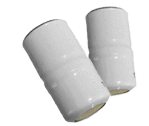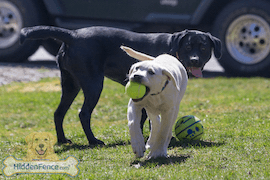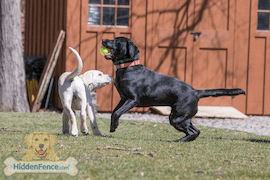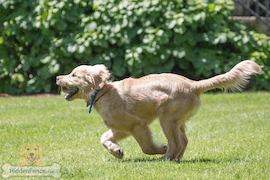Call/Text (973) 442-1111
Pet Containment Training with GentleSteps™
GentleSteps™ training was written by Hidden Fence Owner Rich Weinssen for the national Pet Stop® dealer network. We recommend this training approach as a model, and tailor individual programs for the dogs we train in person.
Introduction to Training
Prepare for the Training
- Place collar on your dog 1 hour or more before training session and remove 1 hour after each training session.
Note: Collars should be removed at night to prevent neck sores.
- A session consists of 10-20 minutes of training followed by 10-20 minutes of play in the yard, 2 or more times daily.
- GentleSteps may take a few days up to a few weeks, plus supervised time ongoing.
- Begin each session by preparing some outstanding treats.
(Try this! Cut up many small pieces of human grade beef or chicken.)
- Training starts in the yard with some treat rewarded basic commands, like sit, look up for your name, etc. Continue with treats, ball or toy play and belly rubs well after fence training is completed.
- In any session, if dog seems particularly stressed for more than a minute or two, (eyes wide, panting, agitated, frantic, tail tucked, pulling towards house, etc), take the collar off and spend extra time near the flag line to calm your pet fully (10-20 minutes after the last correction) with belly rubs, back scratches, treats and your own enthusiasm before going inside.
- Demonstrating sad or sympathetic behavior at any time can confirm for the dog that something is wrong, whereas a happy, playful, treat-generous handler will improve a pet’s mood more efficiently.
- Don’t use a containment system for a dog with existing or developing aggression problems. We recommend professional training help first.
Note: Collars should be removed at night to prevent neck sores.
(Try this! Cut up many small pieces of human grade beef or chicken.)
Training Guidelines
Step 1.
Teach your pet to turn the gentle stimulation on and off. This step allows your pet to make and learn from mistakes using gentle pressure. Average collar setting: LOW then increase incrementally. 6’-20’ Leash on dog, held by handler. Handler allows dog to go no more than 2-3 feet into avoidance zone.
Using mild temptations, tempt your pet to approach or walk past the flags. The fence collar’s tone will sound when your pet enters the avoidance area. Using the leash, return your pet back into the safe zone of the yard within 2-3 seconds and reward generously. Do not allow longer corrections.
Your pet’s responses may vary from very startled to unaware- the more mistakes your pet makes and can learn from at these lower levels, the less firm corrections will be needed later. Examples of mild temptations include family members standing 10 feet or further outside of the yard or outstanding taste value treats thrown 3-6 feet beyond the flags. Remember: return the dog to the safe zone using the leash within 2-3 seconds and emphasize treats and or play.
Repeat this step to teach your pet how to turn off the stimulation by backing up or to avoid turning it on by not advancing towards the flags. Progress to step 2 when your pet shows some avoidance to the flags and shows comfort 5-6 feet from the flags.
Step 2.
Increase temptations and collar setting as your pet increasingly avoids the flags. Average collar setting: Low to Medium settings, increased incrementally. 6’-20’ Leash on dog, held by handler. Since the collar setting is higher, handler should use leash to bring pet back to safe zone quickly, 1-2 seconds maximum.
Use increased temptations, as your pet should now avoid the flags for mild distractions. Along with increased collar settings, handler should increase treats and play time.
Temptations may include a family member walking quickly and playfully about 10’ outside the flag line, with dog and handler walking along flag line about 20’ behind family member.
Pet may make multiple attempts to cross the flag line. Handler should keep mistakes brief and follow with cheer and treats. Alternatively, in the event handler is working alone, toys thrown past the line can serve as temptations. Also watch for passing neighbors, note bus stop schedules and look for neighbor activity that could serve as real world temptations.
Repeat this step to strengthen flag line avoidance even with moderate real world temptations. Progress to step 3 when your pet avoids the flags for moderate temptations and shows comfort 5-6 feet from the flags.
Step 3.
Use maintenance level collar settings and real world temptations to strengthen avoidance. Average collar setting: Medium to High, increased as needed. (Concentrate now on areas your pet would most likely escape from.) 6’-20’ Leash on dog, held by handler to prevent longer duration corrections at these higher levels.
After 1-2 corrections have been felt and pet is avoiding for all available temptations, allow 20’ leash to drag on ground as dog is supervised and temptations continue.
Real world temptations should include family members walking away from the property, dogs outside the yard, bicycles, children, balls thrown past flags, etc. Even watch for deer, rabbits, squirrels etc. if they excite your pet and use them for temptations.
This step will teach your pet to avoid the yard edge even for highly tempting real world distractions. When your pet rejects each real world temptation 3-4 times consecutively, they are ready for step 4, supervised off leash play time.
Step 4.
Supervised freedom. Your pet should be outside 30-60 minutes per day if possible.
Goal: Your pet should avoid flags despite major distractions, but remain comfortable 3-6 feet into the safe zone for at least 60 days. You are ready to allow your pet free run of the yard when your pet has not felt any corrections for at least 2-4 weeks.
Flag removal: Between 30-60 days, remove every other flag. Then every few days remove a few more until they are gone.
(Increase supervision during flag removal stage.)
Ongoing Responsibilities…
- Check system monthly, by walking dog collar to edge of yard and identifying where it beeps.
- Replace batteries at 4-6 month intervals, or when battery light flashes.
- Make sure collar is snug fitting, high on the neck near the ears and removed daily.
- Do not turn down the transmitter. The two digit reading relates to distance from the wire, not correction level.
- Contact Hidden Fence Company any time your Pet Stop system fails to perform properly.
Contact Hidden Fence
Purchase Replacement Batteries Here
Purchase replacement batteries for your Pet Stop® receiver collars.
Invisible Fence® compatible batteries are also available!






